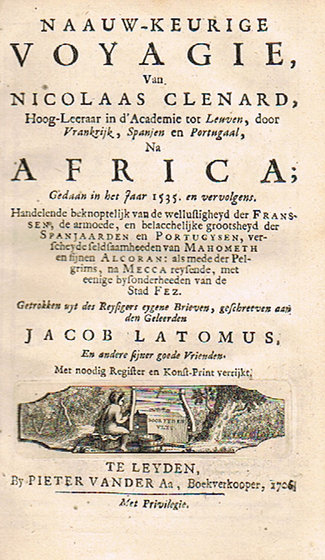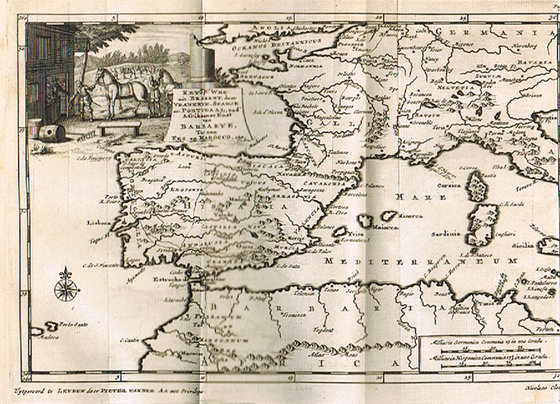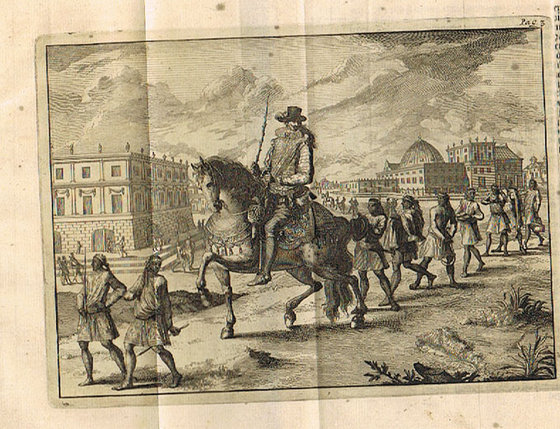NAAUW-KEURIGE VOYAGIE, VAN NICOLAAS CLENARD,...NA AFRICA, GEDAAN IN HET JAAR 1535. VAN DE STAD FEZ
Clenard, Nicolaas
| Numéro d'objet: |
10989 |
| Date: |
1706 |
| Genre: |
Plaquette |
| Lieu: |
Leiden |
| Sujet: |
Voyages |
Recherche dans "Notes":
Nicolas Cleynaerts, connu dans la République des lettres sous le nom de Nicolaus Clenardus, et appelé dans les lettres françaises Nicolas Clénard (5 décembre 1495-1542), est un humaniste, voyageur, savant arabisant et écrivain flamand de langue latine.
Il est immatriculé à l'Université de Louvain le 31 août 1512, comme étudiant à la Paedagogium Porci.
Il était l'ami de Jacques Latomus. Il suit les cours de Guillaume Barlandus et à la fin de ses études est nommé, pour 10 ans, président du collège de Houterlé à Louvain où il enseigne l'hébreu et le grec. L'influence de Juan Luis Vivès et la perspective de la fin de son activité, le montrent de plus en plus convaincu de la nécessité d'apprendre l'arabe et d'étudier la littérature de l'Islam pour convertir les hérétiques. Il peut penser à mettre ce projet à exécution en accompagnant le fils de Christophe Colomb, Fernand, en Espagne, pays proche des royaumes arabes. Cependant, il se voit forcé de faire une halte de quelques années au Portugal où l'appelle le roi Jean III qui veut un précepteur pour achever l'éducation théologique de son frère Don Henri qu'il destine à l'archevêché de Braga. C'est dans cette ville que Clenardus fonde un collège humaniste.
Il trouve un autre protecteur en la personne de Louis Mendoza, marquis de Mondexas, gouverneur général de Grenade où il acquiert une connaissance de l'arabe avec l'aide d'un maure esclave. Après avoir vainement essayé d'avoir accès à des manuscrits arabes de la possession de l'Inquisition espagnole, il peut enfin partir pour l'Afrique, en 1540. Il débarque à Ceuta, alors sous domination portugaise, en passant par Gibraltar. Il atteint Fès, alors lieu florissant de l'apprentissage de l'arabe, mais après quinze mois de privations et de souffrances, il est obligé de retourner à Grenade, où il meurt à l'automne 1542. Il a été enterré dans l'Alhambra.
Nicolas Cleynaerts (Clenardus or Clenard) (December 5, 1495 – 1542), Flemish grammarian and traveller, was born at Diest, in Brabant.
Educated at the University of Leuven, he became a professor of Latin, which he taught by the conversational method. He applied himself to the preparation of manuals of Greek and Hebrew grammar, in order to simplify the difficulties of learners. His Tabulae in grammaticen hebraeam (1529), Institutiones in linguam graecam (1530), and Meditationes graecanicae (1531) appeared at Leuven. The Institutiones and Meditationes passed through a number of editions, and had many commentators. He maintained a principle revived in modern teaching, that the learner should not be puzzled by elaborate rules until he has obtained a working acquaintance with the language.
A desire to read the Koran led him to try to establish a connection between Hebrew and Arabic. These studies resulted in a scheme for proselytism among the Arabs, based on study of the language, which should enable Europeans to combat Islam by peaceful methods. In pursuit of this, he travelled to Spain in 1532, and after teaching Greek at Salamanca was summoned to the court of Portugal as tutor to Dom Henrique, brother of João III.
He found another patron in Louis Mendoza, marquis of Mondexas, governor general of Granada. There with the help of a Moorish slave he gained a knowledge of Arabic. He tried in vain to gain access to the Arabic manuscripts in the possession of the Spanish Inquisition, and finally, in 1540, set out for Africa to seek information for himself.
He reached Fez, then a flourishing seat of Arab learning, but after fifteen months of privation and suffering was obliged to return to Granada, and died in the autumn of 1542. He was buried in the Alhambra.
See his Latin letters to his friends in Flanders, Nicolai Clenardi, Peregrinationum ac de rebus machometicis epistolae elegantissimae (Leuven, 1550), and a more complete edition, Nic. Clenardi Epistolarum libri duo (Antwerp, 1566), from the house of Plantin; also Victor Chauvin and Alphonse Roersch, "Etude sur la vie et les travaux de Nicolas Clenard" in Mémoires couronnes (vol. lx., 1900–1901) of the Royal Academy of Belgium, which contains a vast amount of information on Cleynaerts and an extensive bibliography of his works, and of notices of him by earlier commentators.
1556. Cleynærts van Diest, Nicolaes (better known by his Latinised name of Nicolaus Clenardus).- Nicolai Clenardi Peregrinationum ac de rebus maohometicis Epistolæ elegantissimæ . Lovanii (Louvain) : 8vo.
Another edition in 1561. An abridgement of these letters appeared in Adrian van Nispen's « Reysen wt verscheyde brieven bij een versamelt, » Dordrecht, 1651, 12mo ; and in the « Naauwkeurige Voyage van Nicolaas Clenard na Africa gedaan int' jaar 1535, uit syn eygen brieven byeenverzameld, » as part of a Collection of Voyages, published by Pieter van der Aa, of Leyden, between the years 1707-1709 : « Zee en Land Reysen door Pieter van der Aa, mits garders andere Gewesten geddan, 1246 to 1696, 28 vols. » folio and 8vo.
Some account of him will be found (among other places) in Tiele, « Bouwstoffen voor een bibliog. van Ned. Reisbeschr. » in « Bibliog. Adversaria, » Deel i. p. 37 ; St. Génois, i. p.211, etc. A French translation was published by M. Nève in 1845, q. v.
Clenard went to Fez in 1535 (not 1540, as often affirmed) and stayed a year and a half in that city, for the purpose of profiting by its libraries and learning. His account is valuable, brief though it is, as the first since Leo Africanus wrote. But he seems to have been disappointed with his journey; the scholars of Fez beeing few and the libraries almost non-existent. There was an occasional auction of books at the chief mosque; the volumes being mainly devotional, and the attendants at the sale more frequently idlers attracted by curiosity than veritable purchasers.
André Collin
Traces Belges au Maroc
P. 186





